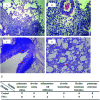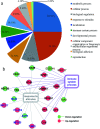iTRAQ based proteomic analysis of PM2.5 induced lung damage
- PMID: 35517034
- PMCID: PMC9063425
- DOI: 10.1039/c9ra00252a
iTRAQ based proteomic analysis of PM2.5 induced lung damage
Abstract
Haze pollution has become a global environmental problem, subsequently affecting air quality, climate, economy and human health. Notably, PM2.5 (particulate matter with an aerodynamic diameter less than 2.5 micrometers) significantly accounts for a variety of adverse health effects, in particular pulmonary diseases such as asthma and lung cancer. Clinical diagnosis and medical treatment of the lung damage caused by PM2.5 still remain significant challenges due to the lack of specific biomarkers and pathways. Here, we established a rat model of nonsurgical intratracheal instillation to investigate PM2.5 exposure and employed iTRAQ based analytical technique and bioinformatics tools to identify putative biomarkers and pathways. We identified 163 differentially expressed proteins (DEPs). Among these proteins, we screened six DEPs (HMOX1, MP2K5, XRCC1 E9PTZ7, KNT2 and A1AG) as the putative biomarkers, with significant differentially expressed levels (percentage increment > 140%). Pathway analysis indicated that calcium signaling, MAPK and PI3K/AKT might be involved in the process of PM2.5-induced lung damage. Western-blotting was used to verify DEPs in the AEC-II cell model for early diagnosis. In summary, our data can serve as fundamental research clues for further studies of PM2.5-induced toxicity in the lungs.
This journal is © The Royal Society of Chemistry.
Conflict of interest statement
The authors declare no competing financial interests.
Figures







Similar articles
-
Amelioration of PM2.5-induced lung toxicity in rats by nutritional supplementation with biochanin A.Ecotoxicol Environ Saf. 2020 Oct 1;202:110878. doi: 10.1016/j.ecoenv.2020.110878. Epub 2020 Jun 22. Ecotoxicol Environ Saf. 2020. PMID: 32585486
-
Effects of concentrated ambient particles on normal and hypersecretory airways in rats.Res Rep Health Eff Inst. 2004 Aug;(120):1-68; discussion 69-79. Res Rep Health Eff Inst. 2004. PMID: 15543855
-
Proteomic characteristics of PM2.5 -induced differentially expressed proteins in human renal tubular epithelial cells.Environ Toxicol Pharmacol. 2021 Aug;86:103658. doi: 10.1016/j.etap.2021.103658. Epub 2021 Apr 16. Environ Toxicol Pharmacol. 2021. PMID: 33862201
-
The toxicity of ambient fine particulate matter (PM2.5) to vascular endothelial cells.J Appl Toxicol. 2021 May;41(5):713-723. doi: 10.1002/jat.4138. Epub 2021 Jan 25. J Appl Toxicol. 2021. PMID: 33496025 Review.
-
Potential effects of noxious chemical-containing fine particulate matter on oral health through reactive oxygen species-mediated oxidative stress: Promising clues.Biochem Pharmacol. 2020 Dec;182:114286. doi: 10.1016/j.bcp.2020.114286. Epub 2020 Oct 15. Biochem Pharmacol. 2020. PMID: 33069666 Review.
Cited by
-
Trajectory of fine particles removal with diffusiophoresis and thermophoresis in a gas-liquid cross-flow array.RSC Adv. 2019 Aug 27;9(46):26748-26756. doi: 10.1039/c9ra04436a. eCollection 2019 Aug 23. RSC Adv. 2019. PMID: 35528569 Free PMC article.
-
Prolonged exposure to traffic-related particulate matter and gaseous pollutants implicate distinct molecular mechanisms of lung injury in rats.Part Fibre Toxicol. 2021 Jun 25;18(1):24. doi: 10.1186/s12989-021-00417-y. Part Fibre Toxicol. 2021. PMID: 34172050 Free PMC article.
-
Proteomic analysis reveals activation of platelet- and fibrosis-related pathways in hearts of ApoE-/- mice exposed to diesel exhaust particles.Sci Rep. 2023 Dec 19;13(1):22636. doi: 10.1038/s41598-023-49790-y. Sci Rep. 2023. PMID: 38114606 Free PMC article.
References
-
- Huang R. J. Zhang Y. Bozzetti C. Ho K. F. Cao J. J. Han Y. Daellenbach K. R. Slowik J. G. Platt S. M. Canonaco F. Zotter P. Wolf R. Pieber S. M. Bruns E. A. Crippa M. Ciarelli G. Piazzalunga A. Schwikowski M. Abbaszade G. Schnelle-Kreis J. Zimmermann R. An Z. Szidat S. Baltensperger U. El Haddad I. Prevot A. S. Nature. 2014;514:218–222. doi: 10.1038/nature13774. - DOI - PubMed
LinkOut - more resources
Full Text Sources

